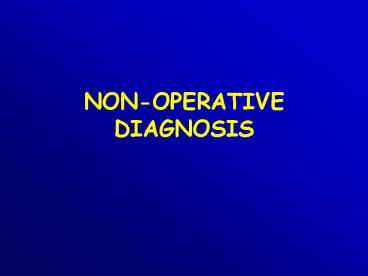NONOPERATIVE DIAGNOSIS PowerPoint PPT Presentation
1 / 19
Title: NONOPERATIVE DIAGNOSIS
1
NON-OPERATIVE DIAGNOSIS
2
NON-OPERATIVE DIAGNOSIS
- Pathology is part of triple assessment
clinical, radiological and pathological - Pathological methods
- Fine Needle Aspiration
- Needle Core biopsy
- Mammotome
3
FINE NEEDLE ASPIRATION
- Uses 21G, 23G, 25G needle
- Highly operator dependent
- Well tolerated by patients
- Suitable for rapid diagnosis one stop clinics
- Method of choice for palpable lumps and
impalpable masses??
4
FINE NEEDLE ASPIRATION
- Diagnostic categories
- C1 Insufficient
- C2 Benign
- C3 Atypical, probably benign
- C4 Suspicious of malignancy
- C5 Unequivocally malignant
5
FINE NEEDLE ASPIRATION
- Major diagnostic criteria
- Cellularity, cohesion, nucler size,
presence/absence of myopeithelial bare nuclei - Minor diagnostic criteria
- Pleomorphism, nuclear irregularity, prominent
nucleoli, nuclei overlapping/evenly spaced
6
CORE NEEDLE BIOPSY
- Uses a spring loaded biopsy gun, 14G needle which
removes a core of tissue - Requires formalin fixation, processing and
embedding which require approx 24 hours not
suitable for one stop clinics
7
CORE NEEDLE BIOPSY
- Advantages of core biopsy
- Many pathologists are more familiar with
histology rather than cytology - Can see microcalcification on specimen X-ray
- Can distinguish in situ from invasive carcinoma
8
CORE NEEDLE BIOPSY
- Reporting categories
- B1 normal or inadequate
- B2 specific benign
- B3 lesion of uncertain malignant potential
- B4 suspicious of malignancy
- B5 malignant in situ
- B5 malignant - invasive
9
Nottingham Prognostic Index
- Tumour size
- Invasive only
- If multiple largest tumour only
- If bilateral, calculate for each side
10
Predictive factors
- ER/PR and HER-2
- ER often sufficient if ER negative, PR may be
helpful - Should be done on all tumours and all cases of
DCIS/LCIS - Scoring systems H score and Quik score
11
HER-2
- Human Epidermal Growth Factor
- Target of Herceptin treatment
- Immunohistochemistry
- Score as -, , ,
- is regarded as positive
- requires FISH presently sent to Glasgow
12
In situ carcinoma
- Ductal carcinoma in situ
- Lobular carcinoma in situ
- Mixed ductal/lobular carcinoma in situ
- Loss of e-cadherin immunoreactivity seems to be
specific for LCIS
13
In situ carcinoma
- Total mastectomy is generally curative
- If breast conserving surgery carried out, the
risk in the ipsilateral breast is greater with
DCIS - Time to development of invasion is less in DCIS
14
In situ carcinoma
- LCIS clinical follow up tamoxifen
- Most patients with DCIS do not go on to develop
invasive ca risk reduced by DXT /- tamoxifen - Risk in contralateral breast is greatest for LCIS
15
In situ carcinoma
- ER status essential
- Assess invasion using collagen IV or laminin
- Microinvasion less than 1mm, often has a ductal
NST pattern
16
Van Nuys prognostic index
- Size 15mm or less 1 point, 1640mm 2, 41mm
or more 3 - Margin 10mm or more 1, 1-9mm 2, less than 1
3 - Pathology not HG, no necrosis 1, not HG,
necrosis present 2, HG /- necrosis 3
17
LYMPH NODE STATUS
- Factors affecting lymph node yield
- Patient
- Surgeon
- Pathologist
- Definition of lymph node positive
18
LYMPH NODE STATUS
- Careful dissection of axillary fat
- Small nodes lt5mm submitted intact
- 5-10mm bisected and one half examined
- 10mm - one section per 10mm
- H and E stained sections may examine gt1 section
19
LYMPH NODE STATUS
- Immunostains for cytokeratin may be helpful in
difficult cases not used routinely - Sentinel nodes single node 1 H and E per mm
and 1 immunostained slide per mm

